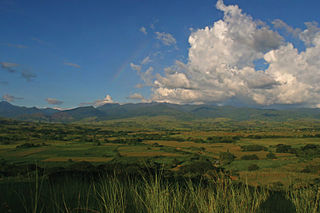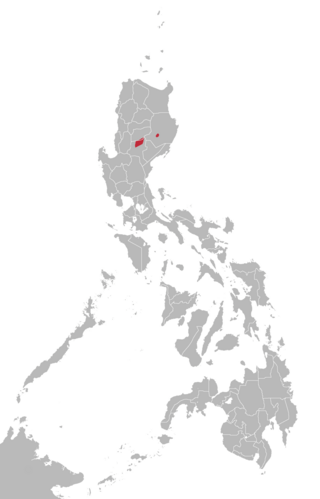Ganda or Luganda is a Bantu language spoken in the African Great Lakes region. It is one of the major languages in Uganda and is spoken by more than 5.56 million Baganda and other people principally in central Uganda, including the country's capital, Kampala. Typologically, it is an agglutinative, tonal language with subject–verb–object word order and nominative–accusative morphosyntactic alignment.

Cagayan, officially the Province of Cagayan, is a province in the Philippines located in the Cagayan Valley region, covering the northeastern tip of Luzon. Its capital is the city of Tuguegarao. It is about 431 kilometres (268 mi) northwest of Manila, and includes the Babuyan Islands to the north. The province borders Ilocos Norte and Apayao to the west, and Kalinga and Isabela to the south.

Kapampangan, Capampáñgan, or Pampangan is an Austronesian language, and one of the eight major languages of the Philippines. It is the primary and predominant language of the entire province of Pampanga and southern Tarlac, on the southern part of Luzon's central plains geographic region, where the Kapampangan ethnic group resides. Kapampangan is also spoken in northeastern Bataan, as well as in the provinces of Bulacan, Nueva Ecija, and Zambales that border Pampanga. It is further spoken as a second language by a few Aeta groups in the southern part of Central Luzon. The language is known honorifically as Amánung Sísuan.
Tagalog grammar are the rules that describe the structure of expressions in the Tagalog language, one of the languages in the Philippines.

The Ibanag are an ethnolinguistic minority numbering a little more than half a million people, who inhabit the provinces of Cagayan, Isabela, and Nueva Vizcaya. They are one of the largest ethnolinguistic minorities in the Philippines.

Cabagan, officially the Municipality of Cabagan, is a 1st class municipality in the province of Isabela, Philippines. According to the 2020 census, it has a population of 53,897 people.
The Japanese Sign Language syllabary is a system of manual kana used as part of Japanese Sign Language (JSL). It is a signary of 45 signs and 4 diacritics representing the phonetic syllables of the Japanese language. Signs are distinguished both in the direction they point, and in whether the palm faces the viewer or the signer. For example, the manual syllables na, ni, ha are all made with the first two fingers of the hand extended straight, but for na the fingers point down, for ni across the body, and for ha toward the viewer. The signs for te and ho are both an open flat hand, but in te the palm faces the viewer, and in ho it faces away.
Afrihili is a constructed language designed in 1970 by Ghanaian historian K. A. Kumi Attobrah to be used as a lingua franca in all of Africa. The name of the language is a combination of Africa and Swahili. The author, a native of Akrokerri (Akrokɛri) in Ghana, originally conceived of the idea in 1967 while on a sea voyage from Dover to Calais. His intention was that "it would promote unity and understanding among the different peoples of the continent, reduce costs in printing due to translations and promote trade". It is meant to be easy for Africans to learn.
Tamambo, or Malo, is an Oceanic language spoken by 4,000 people on Malo and nearby islands in Vanuatu. It is one of the most conservative Southern Oceanic languages.

Rukai is a Formosan language spoken by the Rukai people in Taiwan. It is a member of the Austronesian language family. The Rukai language comprises six dialects, which are Budai, Labuan, Maga, Mantauran, Tanan and Tona. The number of speakers of the six Rukai dialects is estimated to be about 10,000. Some of them are monolingual. There are varying degrees of mutual intelligibility among the Rukai dialects. Rukai is notable for its distinct grammatical voice system among the Formosan languages.
Ilocano grammar is the study of the morphological and syntactic structures of the Ilocano language, a language spoken in the northern Philippines by ethnic Ilocanos and Ilocano communities in the US, Saudi Arabia and other countries around the globe.
Zande is the largest of the Zande languages. It is spoken by the Azande, primarily in the northeast of the Democratic Republic of the Congo and western South Sudan, but also in the eastern part of the Central African Republic. It is called Pazande in the Zande language and Kizande in Lingala.
Ilocano particles are an aspect of Ilocano grammar. Particles lack a meaning independent of a phrase or clause. For the most part, they impart meaning to the phrase or clause in which they occur.

The Gaddang language is spoken by up to 30,000 speakers in the Philippines, particularly along the Magat and upper Cagayan rivers in the Region II provinces of Nueva Vizcaya and Isabela and by overseas migrants to countries in Asia, Australia, Canada, Europe, in the Middle East, United Kingdom and the United States. Most Gaddang speakers also speak Ilocano, the lingua franca of Northern Luzon, as well as Tagalog and English. Gaddang is associated with the "Christianized Gaddang" people, and is closely related to the highland tongues of Ga'dang with 6,000 speakers, Yogad, Cagayan Agta with less than 1,000 and Atta with 2,000, and more distantly to Ibanag, Itawis, Isneg and Malaweg.

Itawis is a Northern Philippine language spoken by the Itawis people, closely related to the Gaddang speech found in Isabela and Nueva Vizcaya. It also has many similarities to the neighboring Ibanag tongue, while remaining quite different from the prevalent Ilocano spoken in the region and the Tagalog-based Filipino national language.
Fuliiru, or Kifuliiru, is a Great Lakes Bantu language spoken by the Fuliiru people (Bafuliiru), also known as the Fuliru, who live north and west of the town of Uvira in Uvira Territory, South Kivu Province in the far eastern part of the Democratic Republic of the Congo (DRC). It is closely related to Kinyindu.
Ila (Chiila) is a language of Zambia. Maho (2009) lists Lundwe (Shukulumbwe) and Sala as distinct languages most closely related to Ila. Ila is one of the languages of the Earth included on the Voyager Golden Record.

Ilocano is an Austronesian language spoken in the Philippines, primarily by Ilocano people and as a lingua franca by the Igorot people and also by the native settlers of Cagayan Valley. It is the third most-spoken native language in the country.
Chichewa is the main language spoken in south and central Malawi, and to a lesser extent in Zambia, Mozambique and Zimbabwe. Like most other Bantu languages, it is tonal; that is to say, pitch patterns are an important part of the pronunciation of words. Thus, for example, the word chímanga (high-low-low) 'maize' can be distinguished from chinangwá (low-low-high) 'cassava' not only by its consonants but also by its pitch pattern. These patterns remain constant in whatever context the nouns are used.
Swahili is a Bantu language which is native to or mainly spoken in the East African region. It has a grammatical structure that is typical for Bantu languages, bearing all the hallmarks of this language family. These include agglutinativity, a rich array of noun classes, extensive inflection for person, tense, aspect and mood, and generally a subject–verb–object word order.








